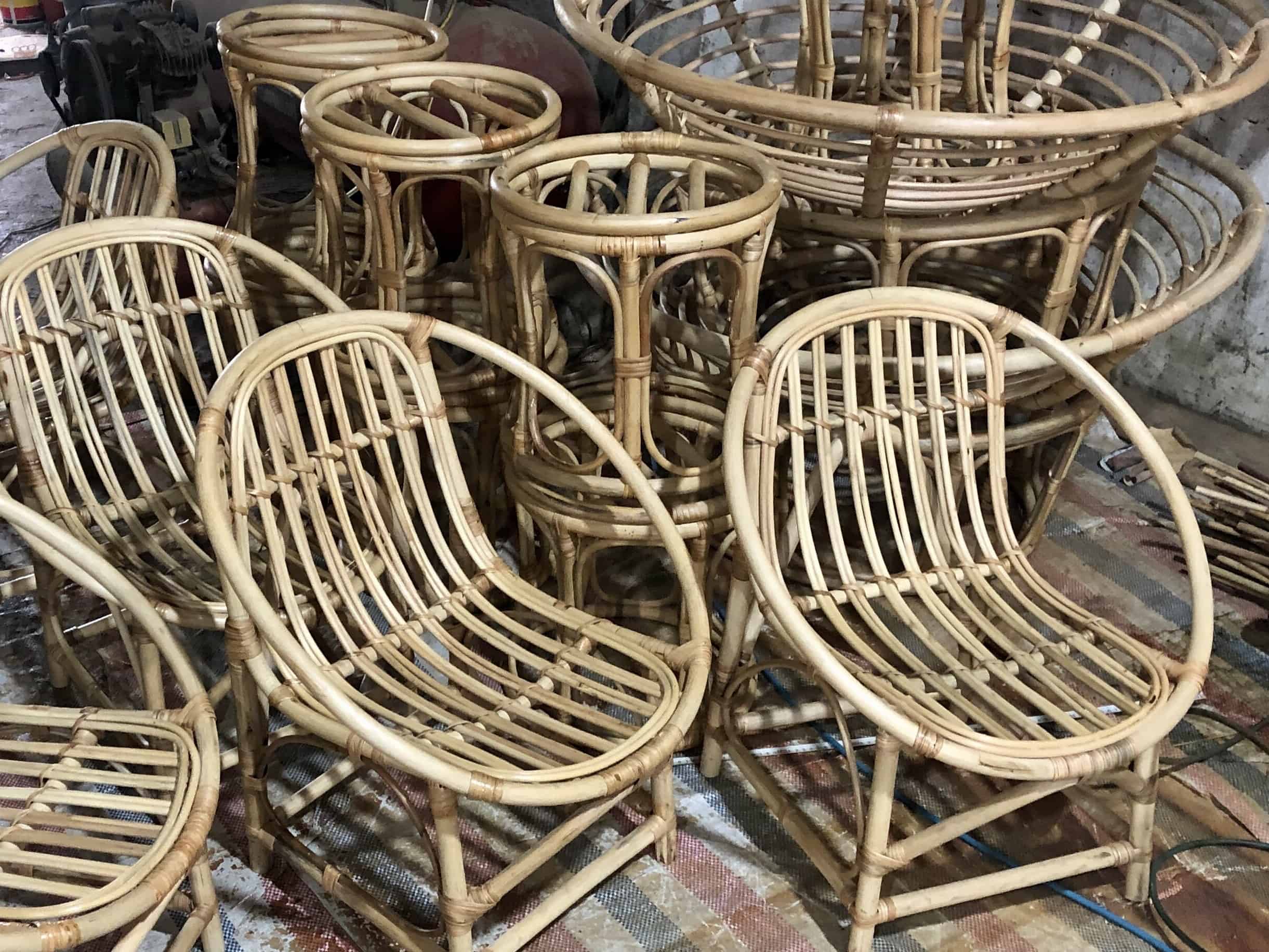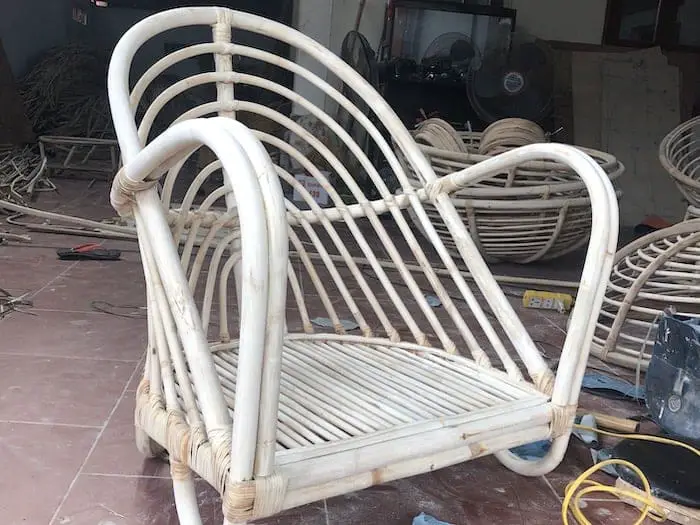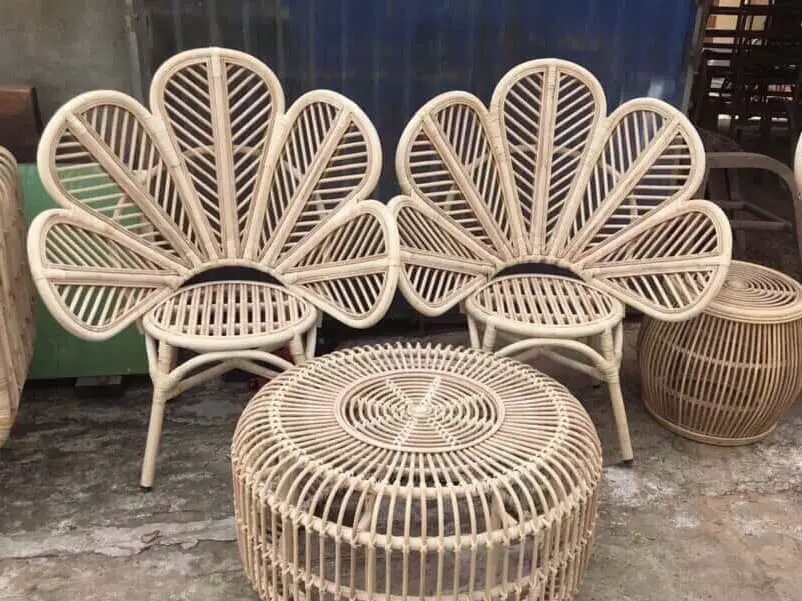There can be a lot of confusion about the difference between rattan and bamboo. People may use words interchangeably, but they are very different natural materials.
Rattan is best described as a climbing palm that will scramble through a forest and grow overall vegetation. Rattan is a perfect material for home decor furniture and accessories as it is natural and strong but can also take a variety of stains and paints. Many steps must be taken to process rattan properly. Vietnam has a long history of rattan and bamboo production.
Table of Contents
- What Is Rattan?
- Why Use Rattan?
- Processing Rattan Furniture and Accessories
- Rattan Production in Vietnam
- Developing Home Decor Products in Rattan
- 10 Reasons Why Rattan is a Superior Natural Material
- Frequently Asked Questions
- Related Questions

What Is Rattan?
Rattan is the name of over 600 species of climbing palm. It was also known as Manila or Malacca, which is named after the shipment ports of Manila and Malacca, But today, most people just refer to it simply as rattan or rattan cane.
It is a woody climbing stem but not a true wood. The rattan grows and scrambles through a forest and grows over all kinds of vegetation.
Though rattan is similar to bamboo, it is not the same as bamboo, and the two natural materials will grow very differently. One of the best ways to describe rattan is that it is a vine that curves, winds, and grows over other vegetation, whereas bamboo grows straight up. To find out more about Bamboo, you can read our blog entitled Bamboo – An Auspicious Plant For Your Home by clicking here.
Rattan will have slender stems that are 2 to 5 cm in size and long internodes between the leaves. But bamboo, on the other hand, is hollow inside it and will grow relatively straight. Bamboo can grow to large diameters but is very strong and hard to bend.
Rattan, on the other hand, is a solid material and will bend and curve as it grows. It can grow quite long but is limited in its overall size or diameter. Some rattan has been known to grow over 100 Meters or 328 Feet long.

Why Use Rattan?
Rattan is known to be a very good material for making baskets and furniture: trays and even mats. The reason is that the natural rattan material will accept paints and stains like many other kinds of natural woods. This means it is very versatile.
The inner core of the rattan is also split and can be used to weave wicker home decor products. This is where it can get confusing as many people see wicker as a kind of material, but wicker is really a weave. You can read more about this by reading our blog Hand-weaving Faux Rattan In Vietnam, What You Need to Know by clicking here.
Processing Rattan Furniture and Accessories
There are quite a few steps that must take place to properly process the rattan and make rattan furniture and home decor accessories.
Cutting Rattan
First, the rattan must be found and cut in the forests. Once it is cut, it must be sorted. Normally once the cane is cut, it may be left in the forest for a week or so with the bunches of rattan placed in bundles of approximate sizes up to 20 to 30 cane pieces in a bundle. These bundles will be kept in an erect position and placed against some trees. This allows sap and water to drain off the cut rattan pieces.
Preparing Rattan
The rattan must be prepared so that it can be used. The major steps for this include:
- Drying the Rattan Cane – Rattan must be appropriately dried, and the moisture content must be checked to ensure the highest quality possible rattan. The rattan poles may also be spread out on the open ground to dry in the sun. The primary purpose of this process is to get the moisture of the rattan cane and the water out of the rattan. Also, during the drying process, the rattan cane, when still wet. can be pulled and straightened.
- Curing the Rattan Cane – The rattan cane will then be immersed in hot oil to prevent deterioration and further reduce the moisture content. The stems of the rattan may also be cut at this stage.
- Deglazing – Some rattan species may have a lot of crusts or other things on the surface so they may need to be deglazed or have the out part completely taken off.
Video About Bending Rattan
Here is a video to show how Rattan Furniture parts are shaped and bent with fire. Click on the link below to view the video.
Manufacturing Rattan Products
Once the rattan has been adequately prepared, it is usually sold to another manufacturer who processes the raw rattan materials into home decor accessories and home furniture products. Here are the basic steps that must be taken while manufacturing home decor and home furniture products.
- Prepare for Bending – The rattan is usually prepared for bending in two different ways – one is by boiling the rattan, and another is with fire. Both of these methods allow the rattan to bend.
- Bending Into Shape – Once the rattan has been prepared for bending, it can be bent into various shapes. With the actual manufacturing of rattan home decor furniture and accessory products, small nails are used. The rattan is also wrapped with leather or rattan stripes to hold the rattan in place.
- Finishing – Once the rattan is finished, it can be stained or painted.
Rattan Production in Vietnam
Vietnam is a country that has traditionally always had a lot of rattan and bamboo materials and production. Most Vietnamese have grown up with rattan furniture in their home. There is even a traditional-style rattan chair that the famous Vietnamese leader Ho Chi Minh was said to have used. This chair is now called the Ho Chi Minh chair.

Today, you can go up to the mountain regions of Vietnam and find many hill tribes still weaving their backpacks, baskets, and other items to be used daily. Many hill tribe children may still walk to school with their woven backpacks.
Vietnam has over 700 handicraft villages that produce bamboo and rattan scattered all over the countryside. Some bamboo and rattan handicraft villages are very small, and others have larger-scale production. These households have been weaving and producing rattan and bamboo products for hundreds of years.
Developing Home Decor Products in Rattan
Many home decor products can be manufactured with rattan. Here are some of our suggestions:
- Furniture – Rattan has long been a staple for all furniture production. This is because it is strong yet can be bent into the required shape.
- Baskets – One of the top ways it can be used in home decor production is basket production. A lot of rattan material is used in home decor for basket production.
- Mirrors and Wall Art – Rattan can be bent for mirrors and wall art. This is a great way to give your wall decor a nice, natural look.
- Lamp and Lighting – Rattan can also be used for various lampshades and lighting products.
- Trays, Boxes, and other home decor accessories – Rattan can be used for various home decor accessories such as trays, boxes, and other accessories.
As natural products continue to be a significant trend, there is no doubt that rattan and all kinds of rattan products will play a central role in developing and manufacturing home decor products. This is because rattan is a great, versatile natural material.
10 Reasons Why Rattan is a Superior Natural Material
Rattan, a name often associated with intricately designed furniture and decorative pieces, is a naturally-grown vine found primarily in the Southeast Asian region. Not only does it lend an exotic, timeless aesthetic to various products, but it also boasts numerous advantages over other materials.
Here are ten reasons why rattan stands out as a superior natural material:
- Sustainable Growth: Rattan is fast-growing and can mature in just 5-7 years. This rapid growth rate makes it an excellent renewable resource, contributing to environmental sustainability.
- Durable and Long-lasting: Rattan is incredibly sturdy and resilient despite its lightweight nature. With proper care, rattan furniture and products can last for decades, making them a valuable investment.
- Flexible Yet Strong: Rattan can be easily shaped into various intricate designs without compromising its structural integrity. This makes it ideal for creating uniquely styled furniture and household items.
- Natural Aesthetic: With its rich, earthy tones and unique texture, rattan seamlessly integrates with both contemporary and traditional interiors, offering a timeless appeal.
- Eco-friendly: Being a natural material, rattan doesn’t contribute to the pollution caused by synthetic materials. Moreover, when a rattan product reaches the end of its life cycle, it decomposes naturally without harming the environment.
- Easy Maintenance: Rattan requires minimal upkeep. Simple dusting, occasional cleaning with a damp cloth, and avoiding excessive moisture can keep it in pristine condition for years.
- Breathable: Unlike solid wood or metal furniture, the woven nature of rattan products allows for better air circulation. This makes rattan chairs and sofas more comfortable during warmer months.
- Lightweight: Rattan products are typically much lighter than their solid wood or metal counterparts, making them easy to move and rearrange as desired.
- Supports Local Economies: The cultivation and crafting of rattan products provide livelihoods to many communities in Southeast Asia. By choosing rattan, consumers indirectly support these artisans and their traditional skills.
- Versatility: Rattan can be combined with other materials, such as metal frames or glass tops, to create hybrid products. Its adaptability allows for innovation in design, ensuring there’s something for every taste and preference.
Rattan is not just a style statement but a testament to nature’s brilliance. Its benefits are manifold – from environmental sustainability to design versatility – making it an exceptional choice for those who value aesthetics and ethics in their material selections.
Find out more about how Mondoro can help you create, develop, and manufacture excellent home decor and furniture products – don’t hesitate to contact me, Anita. Check out my email by clicking here or become a part of our community and join our newsletter by clicking here.
Mondoro gives out a FREE Lookbook to anyone interested. You can receive a copy of our latest Lookbook by clicking here.
Listen to our Podcast called Global Trade Gal. You can find it on all major podcast platforms. Try out listening to one of our podcasts by clicking here.
Subscribe to our Mondoro Company Limited YouTube Channel filled with great videos and information by clicking here.
Frequently Asked Questions
What is rattan?
Rattan is a type of climbing palm that is commonly used to create furniture and other decorative items.
What makes rattan a popular choice for furniture?
Rattan is lightweight, durable, and flexible, making it a great choice for creating comfortable and stylish furniture.
How is rattan harvested?
Rattan is harvested by cutting the stems from the palm plant and then treating them to make them more pliable and durable.
What are some popular rattan products?
Rattan products include chairs, sofas, tables, baskets, and decorative items such as wall hangings and lampshades.
Is rattan a sustainable material?
Yes, rattan is considered a sustainable material because it grows quickly and can be harvested without causing damage to the plant or the environment.
What are the benefits of using rattan in furniture?
Rattan is a lightweight and flexible material that is also very durable, making it a great choice for creating comfortable, stylish, and long-lasting furniture.
What is the average lifespan of rattan furniture?
With proper care, rattan furniture can last for many years, making it a great investment for your home or outdoor space.
Is rattan furniture easy to clean?
Rattan furniture is generally easy to clean and maintain with regular dusting and wiping down with a damp cloth.
What other materials are commonly used in conjunction with rattan?
Rattan is often combined with materials such as wood, metal, and glass to create unique and stylish furniture pieces
Are rattan chairs comfortable?
Yes, rattan chairs are known for being both comfortable and stylish, making them a popular choice for both indoor and outdoor use.
Related Questions
What is Seagrass Material used in Home Decor?
Seagrass is exactly as the name implies, a grass that grows in the sea or in areas that have saltwater. As Vietnam has access to a lot of tropical oceans, seagrass is abundant in Vietnam. A lot of the seagrass used for manufacturing home decor products is farmed to be cut and processed specifically for seagrass weaving. This seagrass is cut, dried, spun, dyed, and then woven into a lot of different items, including baskets, lampshades, furniture, and area rugs. But seagrass also has some great eco-friendly properties, making it a great alternative to plastic.
You can find out more about seagrass by reading our blog, Eco-Friendly Seagrass Materials Used in Home Decor Products by clicking here.
What is Water Hyacinth Material Used in Home Decor?
Water hyacinths used to be a nuisance on the waterways around Vietnam as the water hyacinth plant grows on the water and is extremely fast-growing. Today, the plant is cut and dried and then handwoven into beautiful baskets and other home decor products. The water hyacinth material can be left in its natural color, dyed, or painted in various shapes and forms.
You can find out more by reading our blog About Weaving Water Hyacinth Baskets Into Home Décor Products by clicking here.


